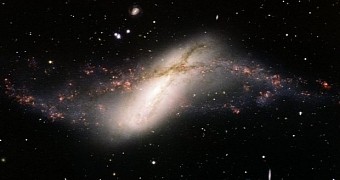A mindbogglingly distant black hole that lay dormant for perhaps millions of years is now at long last waking up from its prolonged slumber and beginning to feast on material more or less willingly offered as sacrifice by its home galaxy.
The freshly resurrected black hole, studied by a group of researchers including Sam Connolly of the University of Southampton with the help of ground- and space-based telescopes, lies at a distance of about 42 million light-years from our planet, at the core of a galaxy dubbed NGC 660.
When comparing views of this faraway galaxy obtained in recent years, astronomers noticed that, in 2012, NGC 660 suddenly turned much brighter than it was just a couple of years back, in 2010.
True, galaxies are known to transform as they gain and lose stars. However, the increase in brightness documented in the case of NGC 660 was too sudden and too intense to be attributed to a boom in star formation.
Instead, astronomer Sam Connolly and his colleagues propose that the reason the galaxy flared up was because the black hole located at its center woke up and began to feed on gas and dust, all the while producing ginormous jets.
Indeed, recent views of NGC 660 show a bright radio source at its center. Since dormant black holes do not emit all that much radiation, this can only mean that the one lying at the center of this distant galaxy is now awoken.
“As supermassive black holes are so huge, they evolve very slowly, remaining dormant for thousands of years at a time, so to catch one waking up is really incredible,” said researcher Sam Connolly.

 14 DAY TRIAL //
14 DAY TRIAL //